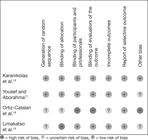ABSTRACT
BACKGROUND AND OBJECTIVES:
Post-amputation pain is very frequent and can become chronic in almost 85% of the cases. The objective of this study was to conduct a systematic review concerning the evidence about the measures for the control or remission of chronic pain in the stump or phantom limb in adults and the elderly after extremity amputation.
CONTENTS:
The search was conducted in the databases Pubmed, Mendeley, Livivo, and Science Direct. Additional searches were performed at ClinicalTrial.gov, Google Scholar, and in the references of the selected articles. Two independent reviewers performed the screening of the studies as well as the data extraction and synthesis. The Cochrane Collaboration Risk of Bias Tool was used to analyze the risk of bias, and four articles were identified. Two articles on pharmacological prevention strategies and two articles on non-pharmacological treatment. The risk of bias was low for the pharmacological approach, and uncertain or high for the non-pharmacological.
CONCLUSION:
The findings suggest a protective effect of preventive pharmacological therapies, epidurally, in combination with bupivacaine and fentanyl or added to calcitonin, in the perioperative period. Promising data are also presented for non-pharmacological therapies for pain control, phantom motor execution and gradual motor images. However, caution is necessary due to the risk of bias and considering the number of studies that answer the research question. Additional studies are suggested to strengthen the evidence, especially with quantitative analysis.
Keywords:
Amputation; Perioperative period; Phantom limb; Postoperative pain; Therapeutics

 Thumbnail
Thumbnail
 Thumbnail
Thumbnail

